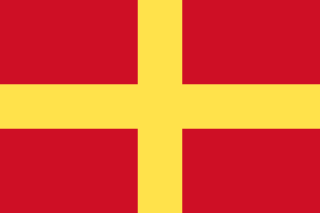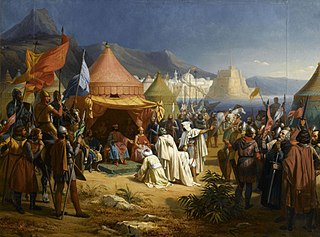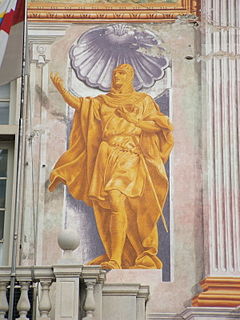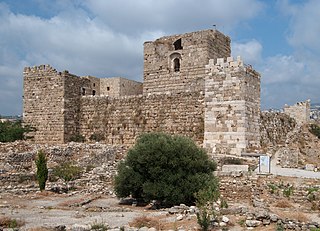Related Research Articles

Byblos, also known as Jubayl or Jebeil, is a city in the Keserwan-Jbeil Governorate of Lebanon. It is believed to have been first occupied between 8800 and 7000 BC and continuously inhabited since 5000 BC, making it one of the oldest continuously inhabited cities in the world. During its history, Byblos was part of numerous civilizations, including Egyptian, Phoenician, Assyrian, Persian, Hellenistic, Roman, Fatimid, Genoese, Mamluk and Ottoman. The city is a UNESCO World Heritage Site.

The County of Tripoli (1102–1289) was the last of the Crusader states. It was founded in the Levant in the modern-day region of Tripoli, northern Lebanon and parts of western Syria which supported an indigenous population of Christians, Druze and Muslims. When the Frankish Crusaders – mostly southern French forces – captured the region in 1109, Bertrand of Toulouse became the first count of Tripoli as a vassal of King Baldwin I of Jerusalem. From that time, the rule of the county was decided not strictly by inheritance but by factors such as military force, favour and negotiation. In 1289 the County of Tripoli fell to Sultan Qalawun of the Muslim Mamluks of Cairo. The county was absorbed into Mamluk Egypt.
Bohemond IV of Antioch, also known as Bohemond the One-Eyed, was Count of Tripoli from 1187 to 1233, and Prince of Antioch from 1201 to 1216 and from 1219 to 1233. He was the younger son of Bohemond III of Antioch. The dying Raymond III of Tripoli offered his county to Bohemond's elder brother, Raymond, but their father sent Bohemond to Tripoli in late 1187. Saladin, the Ayyubid sultan of Egypt and Syria, conquered the county, save for the capital and two fortresses, in summer 1188.
Bohemond VI, also known as the Fair, was the prince of Antioch and count of Tripoli from 1251 until his death. He ruled while Antioch was caught between the warring Mongol Empire and Mamluk Sultanate. In 1268 Antioch was captured by the Mamluks, and he was thenceforth a prince in exile. He was succeeded by his son, Bohemond VII.

Bohemond VII was the count of Tripoli and nominal prince of Antioch from 1275 to his death. The only part left of the once great Principality of Antioch was the port of Latakia. He spent much of his reign at war with the Templars (1277–1282).

Lucia was the last countess of Tripoli, a Crusader state in the Levant.
The Principality of Antioch mirrored the Latin Kingdom of Jerusalem in its selection of great offices: constable, marshal, seneschal, admiral, Chamberlain, butler, chancellor and at certain times also bailiff.

The siege of Tripoli lasted from 1102 until July 12, 1109. It took place on the site of the present day Lebanese city of Tripoli, in the aftermath of the First Crusade. It led to the establishment of the fourth crusader state, the County of Tripoli.

Guillaume de Beaujeu, aka William of Beaujeu was the 21st Grand Master of the Knights Templar, from 1273 until his death during the siege of Acre in 1291. He was the last Grand Master to preside in Palestine.

The Embriaco were a prominent Genoese family, who played an important role in the history of the Crusader states. It also gave consuls, admirals and ambassadors to the Republic of Genoa.
Plaisance of Gibelet was the daughter of Hugh III Embriaco, Lord of Gibelet, and Stephanie of Milly.

Byblos Castle is a Crusader castle in Byblos, Lebanon. In Crusader times it was known as the Castle of Gibelet, also spelled Giblet, which belonged to the Genoese Embriaco family, Lords of the city. It is adjacent to the Phoenician archaeological site containing the ruins of the Temple of Baalat Gebal and the Temple of the Obelisks.
John of Lusignan was a regent of the Kingdom of Cyprus and titular Prince of Antioch. He was son of King Hugh IV of Cyprus and his second wife Alix of Ibelin. He was a member of the House of Lusignan.
Philip of Antioch, also called Philip of Tripoli, was a member of the House of Poitiers who ruled as king of the Armenian Kingdom of Cilicia from 1222 to 1224 as the first husband of Queen Isabella.

The Fall of Tripoli was the capture and destruction of the Crusader state, the County of Tripoli, by the Muslim Mamluks. The battle occurred in 1289 and was an important event in the Crusades, as it marked the capture of one of the few remaining major possessions of the Crusaders. The event is represented in a rare surviving illustration from a now fragmentary manuscript known as the 'Cocharelli Codex', thought to have been created in Genoa in the 1330s. The image shows the countess Lucia, Countess of Tripoli and Bartholomew, Bishop of Tortosa sitting in state in the centre of the fortified city, and Qalawun's assault in 1289, with his army depicted massacring the inhabitants fleeing to boats in the harbour and to the nearby island of St Thomas.
Guido I Embriaco or Guy I of Gibelet was "Lord (Signore) of Gib(e)let" or "Gibelletto", the modern and historic Byblos in Lebanon. He belonged to the Embriaco family.
Stéphanie of Milly, was a noblewoman of the Crusades.
Hugo or Hugh l’Aleman was a nobleman of the Kingdom of Jerusalem.
Guy II or Guido II, surnamed Embriaco, was the lord of Gibelet from about 1271 until his death.
William of Botron was Lord of Botron (1244–1262) in the County of Tripoli, and Constable of Jerusalem (1258–1262).
References
- Tyerman, Christopher, God's war, A new history of the Crusades, ISBN 0-7139-9220-4
- Richard, Jean (1996). Histoire des Croisades (in French). Fayard. ISBN 2-213-59787-1.